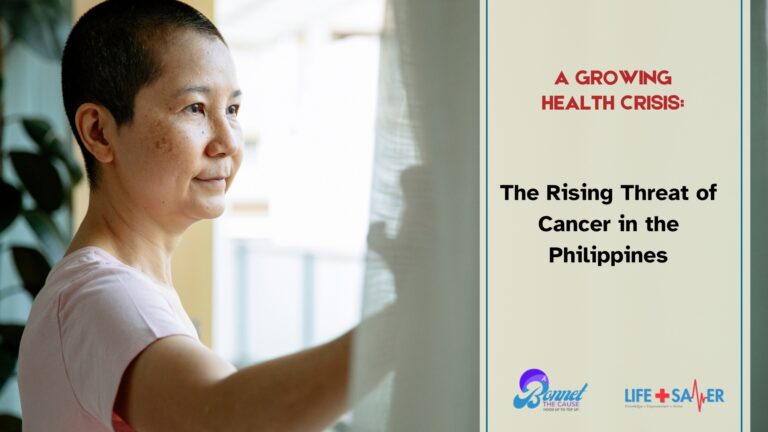Risk Factors Associated with Lung Cancer: Smoking and Environmental Influences in the Philippines
Introduction
February is National Cancer Awareness Month in the Philippines, a time to reflect on the impact of this disease and advocate for prevention and treatment. Cancer is the second leading cause of mortality in the Philippines 1, and lung cancer, in particular, presents a significant health challenge. This article examines the risk factors associated with lung cancer, specifically focusing on the roles of smoking and environmental influences within the Philippine context.
Lung cancer is the leading cause of cancer-related deaths worldwide, with smoking being the primary risk factor 2. While this holds true in the Philippines, unique environmental factors and occupational hazards also contribute to the burden of lung cancer in the country 1. This article aims to provide a comprehensive overview of these factors, drawing upon the latest research and statistics.
Prevalence of Lung Cancer in the Philippines
Lung cancer poses a significant health burden in the Philippines. In 2020, there were 19,180 new cases of lung cancer in the Philippines, accounting for 12.5% of all new cancer cases 3. It is the leading type of cancer among Filipino men, with 13,406 new cases reported in that year 3. Lung cancer is also the most common cause of cancer-related mortality among men in the Philippines 5. Furthermore, it claims the highest mortality rate among all cancers in the Philippines, accounting for 18.4% of cancer-related deaths in 2022 3.
Data from 1998 showed an estimated 11,123 new cases of lung cancer, with 8,474 in males and 2,649 in females 6. The age-standardized incidence rate for lung cancer in males was highest in Manila (58.7/100,000), followed by Rizal (48.3/100,000) and Cebu 6. In females, lung cancer ranked third in both Manila and Rizal, with age-standardized incidence rates of 16.8/100,000 and 12.9/100,000, respectively 6.
While lung cancer contributes significantly to cancer deaths, cancer overall is the third leading cause of death in the Philippines 7.
Smoking as a Risk Factor
Smoking is undeniably the most significant risk factor for lung cancer. Tobacco smoke contains numerous carcinogenic compounds that damage DNA and lead to mutations that can initiate and promote cancer development 8. Studies have consistently shown a strong correlation between smoking and lung cancer incidence, with smokers having a significantly higher risk of developing the disease compared to non-smokers 1. Annually, about 110,000 Filipinos die due to tobacco-attributable diseases 9.
In the Philippines, the prevalence of smoking among adults was 19.5% in 2021, with a much higher prevalence among males (nearly 35%) compared to females (just over 4%) 10. This disparity in smoking rates is reflected in the higher incidence of lung cancer among men 3.
The risk of lung cancer increases with the number of cigarettes smoked and the duration of smoking 1. There is also an approximate three-decade lag time between smoking prevalence and lung cancer rates, meaning that the effects of smoking can manifest years later 11. Even former smokers remain at an elevated risk compared to those who have never smoked, although their risk decreases over time 1. In 2012, the economic burden of tobacco use in the Philippines was just under PHP₱270 billion, highlighting the significant economic impact of smoking in addition to the health consequences 12.
Environmental Influences
Beyond smoking, various environmental factors contribute to lung cancer risk in the Philippines. These include:
Air Pollution
The Philippines faces significant challenges with air quality, particularly in urban areas. High levels of particulate matter (PM2.5) and other pollutants in the air are linked to an increased risk of lung cancer 1. In 2019, air pollution was responsible for an estimated 66,230 deaths in the Philippines 14. The World Health Organization (WHO) has officially classified outdoor air pollution as a leading human carcinogen, similar to tobacco smoke 15. Air pollution disproportionately affects marginalized communities in the Philippines, highlighting the social justice aspect of environmental health risks 16.
Occupational Hazards
Certain occupations expose workers to carcinogens that increase their risk of lung cancer. These include exposure to asbestos, silica, metals, and diesel exhaust 1. In the Philippines, a study of former workers from the Subic Naval Base revealed that 58.75% had asbestos-related interstitial lung or pleural disease 19. Construction workers, in particular, face a high risk of developing occupational lung diseases, including restrictive spirometry pattern (RSP), due to exposure to hazardous materials 20. Asbestos workers have the highest prevalence of RSP (35.3%), followed by teamsters (truck drivers) at 32.9% and boilermakers at 31.2% 20.
Indoor Air Pollution
In many parts of the Philippines, the use of solid fuels for cooking and heating in poorly ventilated spaces contributes to indoor air pollution. These emissions contain harmful substances, including carcinogens such as benzopyrene and formaldehyde 21.
Secondhand Smoke
Exposure to secondhand smoke, even without actively smoking, increases the risk of lung cancer 22. Studies have shown that children exposed to secondhand smoke early in life may have a higher risk of developing lung cancer later on 18. Research also indicates that risk factors for oral cavity cancer, such as passive smoking, chewing tobacco, and inverted cigarette smoking, can contribute to lung cancer risk 23.
Emerging Concerns: Vaping and Cannabis Use
While tobacco smoking remains a primary concern, the increasing use of vaping and cannabis raises new challenges in lung cancer prevention. Although research on the long-term effects of vaping and cannabis smoking is limited, studies suggest potential cardiovascular and cancer risks associated with burning and inhaling any plant product 24.
Other Risk Factors
While smoking and environmental factors play major roles, other factors can also influence lung cancer risk:
- Family History: Individuals with a family history of lung cancer have an increased risk of developing the disease 25. Notably, lung cancer is a leading cause of cancer mortality for Asian American women who have never smoked, emphasizing the significance of environmental factors and genetic predisposition in lung cancer development 25.
- Chronic Lung Diseases: Certain lung diseases, such as tuberculosis and chronic obstructive pulmonary disease (COPD), can increase the risk of lung cancer 25.
- Genetic Predisposition: Emerging evidence suggests that genetic factors may contribute to lung cancer risk, particularly among Asian women who are non-smokers 1.
National Cancer Awareness Month and Life+Saver Events Management Services
National Cancer Awareness Month in the Philippines serves as a crucial platform to raise awareness about cancer prevention, early detection, and treatment. It is a time to mobilize communities, healthcare providers, and policymakers to work together in the fight against cancer. Various organizations and initiatives contribute to this effort, including Life-Saver Events Management Services (Life+Saver).
Life+Saver is committed to supporting cancer patients and their families through its program “Bonnet The Cause.” This program aims to raise awareness and funds for cancer care facilities by selling specially designed bonnets, each featuring a different cancer ribbon 26. This initiative not only promotes awareness but also provides tangible support to those battling cancer.
Life+Saver’s mission and vision align with the spirit of National Cancer Awareness Month by emphasizing the importance of community involvement and support in the fight against cancer. “Bonnet The Cause” exemplifies this commitment by providing a means for individuals to contribute to this important cause.
Conclusion
Lung cancer remains a significant public health concern in the Philippines. While smoking is the primary risk factor, various environmental influences and occupational hazards contribute to the burden of this disease. The majority of lung cancer incidence, mortality, and disease burden occurs among men, but women also have a significant risk 27. This highlights the need for targeted prevention and awareness campaigns for both genders.
National Cancer Awareness Month provides an opportunity to highlight these risk factors and advocate for comprehensive strategies to prevent lung cancer and support those affected by it. The interplay between smoking, environmental factors, and genetic predisposition underscores the need for integrated public health approaches that address both individual and environmental risk factors.
Initiatives like Life+Saver’s “Bonnet The Cause” demonstrate the power of community engagement in raising awareness and providing support to cancer patients and their families. By working together, healthcare professionals, policymakers, and the public can take concrete steps to reduce lung cancer risk in the Philippines. This includes promoting smoking cessation programs, advocating for stricter air quality regulations, raising awareness about occupational hazards, and supporting initiatives that provide care and support to those affected by lung cancer.
NationalCancerAwarenessMonth #LungCancer #Philippines #Smoking #EnvironmentalRisks #AirPollution #OccupationalHazards #SecondhandSmoke #CancerPrevention #EarlyDetection #LifeSaverPH #BonnetTheCause #HealthierPhilippines #SupportCancerPatients
Works Cited
2. Lung cancer – World Health Organization (WHO)
3. All About Lung Cancer | InLife – Insular Life
5. Estimation of lung cancer burden in Australia, the Philippines, and Singapore: an evaluation of disability adjusted life years – PubMed Central
6. CANCER REGISTRATION IN THE PHILIPPINES – WAOCP
7. Financial Sequelae of Cancer for Patients’ Family Members and Caregivers: A Focus on the Philippines | JCO Global Oncology – ASCO Publications
8. The Relationship Between Lung Cancer and Smoking – Unilab
9. GLOBAL ADULT TOBACCO SURVEY: PHILIPPINES COUNTRY REPORT, 2021 3 – GTSS Academy
10. Number of Areas – Tobacco Use in the Philippines, females – Tobacco Tactics
11. Who is at high risk for lung cancer? Population-level and individual-level perspectives – PMC
12. Philippines Country Profile – Tobacco Tactics
13. Relationship between exposure to PM2.5 and lung cancer incidence and mortality: A meta-analysis – PMC
14. Estimating the Health & Economic Cost of Air Pollution in the Philippines – Centre for Research on Energy and Clean Air
15. BENEFICIARIES; AND STATUS OF IMPLEMENTATION A. PROJECTS, PROGRAMS 2018 – Lung Center of the Philippines
16. When breathing is unhealthy – Greenpeace Philippines
17. Environmental and occupational determinants of lung cancer – Shankar
18. Risk factors for the development of lung cancer around the world: a review – Exploration Pub
19. Asbestos-related Diseases in the Philippines: The Lung Center of the Philippines Asbestos Screening Program – Acta Medica Philippina – University of the Philippines Manila/
20. Construction Workers at Increased Risk for Life-Threatening Lung Disease, Study Finds – Duke University School of Medicine
21. LUNG CANCER IN NEVER SMOKERS: CLINICAL EPIDEMIOLOGY AND ENVIRONMENTAL RISK FACTORS – PMC – PubMed Central
22. Philippines | Tobacco and Health Around the World | Global Action to End Smoking
23. Epidemiological Risk Factors for Cancers of the Lung, Breast, Colon-rectum & Oral cavity: A case-control study in the Philippines – Acta Medica Philippina
24. Plenary Session Will Unveil Impact of Non-Tobacco Factors in Lung Cancer Risk – ILCN
25. Elevated risk of lung cancer among Asian American women who have never smoked: an emerging cancer disparity | JNCI – Oxford Academic
26. Life+Saver Philippines – Empowering Communities. Saving Lives
27. Smoking-attributable burden of lung cancer in the Philippines – PubMed







